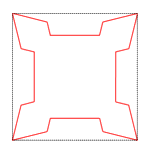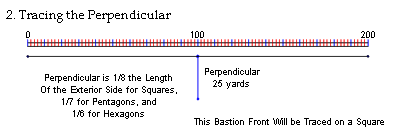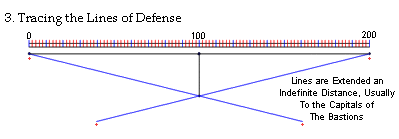 A
bastion front of fortification was composed of five primary sections of parapet
traced on right lines: two faces at opposite extremities of the front and
two flanks that were joined by a central curtain. In field fortification
the defensive relations among these five elements were determined by the
method employed to trace the line of the interior crest of the parapet of
the front. Most engineering manuals of the period presented very similar
methods that projected very similar patterns of crossing columns of fire
over ground exterior to the crest of the counterscarp and eliminated all
dead angles from the ditch. These methods can generally be condensed into
a series of distinct 6 procedures: A
bastion front of fortification was composed of five primary sections of parapet
traced on right lines: two faces at opposite extremities of the front and
two flanks that were joined by a central curtain. In field fortification
the defensive relations among these five elements were determined by the
method employed to trace the line of the interior crest of the parapet of
the front. Most engineering manuals of the period presented very similar
methods that projected very similar patterns of crossing columns of fire
over ground exterior to the crest of the counterscarp and eliminated all
dead angles from the ditch. These methods can generally be condensed into
a series of distinct 6 procedures:
1. Tracing the Exterior Side of the Polygon
of Fortification.
 All
bastion fronts were traced in proportion to the length of the front of
fortification. The front was defined by a right line terminated at well defined
points that marked the angles of the fortified polygon. This right line was
designated as the exterior side of the fortified polygon (this was true whether
or not the bastion front was an element of an open work, such as a hornwork,
or a field work completely or only partially enclosed by bastion fronts).
In field works the maximum length of a front of fortification depended on
the effective range of muskets or other arms employed for its defense; the
minimum length was established by the relief of the work's profile and the
plongee or line of fire of the superior slope of the parapet. D. H. Mahan
suggested a maximum length of 250 yards (which produced lines of defense
about 180 yards long) and a minimum length of 125 yards to produce elements
of the front long enough to project effective columns of fire for the defense
of the work. All
bastion fronts were traced in proportion to the length of the front of
fortification. The front was defined by a right line terminated at well defined
points that marked the angles of the fortified polygon. This right line was
designated as the exterior side of the fortified polygon (this was true whether
or not the bastion front was an element of an open work, such as a hornwork,
or a field work completely or only partially enclosed by bastion fronts).
In field works the maximum length of a front of fortification depended on
the effective range of muskets or other arms employed for its defense; the
minimum length was established by the relief of the work's profile and the
plongee or line of fire of the superior slope of the parapet. D. H. Mahan
suggested a maximum length of 250 yards (which produced lines of defense
about 180 yards long) and a minimum length of 125 yards to produce elements
of the front long enough to project effective columns of fire for the defense
of the work.
2. Tracing the Perpendicular.
 The
exterior side of the fortified polygon was then bisected into two equal halves.
This middle point of the exterior side of the polygon marked the exterior
extremity of the perpendicular which was produced inward (toward the interior
of the field work) on a line perpendicular (hence the name) to the line of
the exterior side of the fortified polygon. Its length was proportional to
the length of the front and number of sides forming the fortified polygon.
For works traced within a square or nearly regular quadrilateral the
perpendicular was 1/8 the length of the exterior side. For pentagons the
perpendicular was taken as 1/7 the length of the exterior side; for hexagons
and all other polygons the perpendicular was 1/6 the length of the exterior
side. The
exterior side of the fortified polygon was then bisected into two equal halves.
This middle point of the exterior side of the polygon marked the exterior
extremity of the perpendicular which was produced inward (toward the interior
of the field work) on a line perpendicular (hence the name) to the line of
the exterior side of the fortified polygon. Its length was proportional to
the length of the front and number of sides forming the fortified polygon.
For works traced within a square or nearly regular quadrilateral the
perpendicular was 1/8 the length of the exterior side. For pentagons the
perpendicular was taken as 1/7 the length of the exterior side; for hexagons
and all other polygons the perpendicular was 1/6 the length of the exterior
side.
3. Tracing the Lines of Defense.
 Lines
were then produced from the extremities of the exterior side of the fortified
polygon an indefinite distance through the interior extremity of the
perpendicular. These were the bastion front's lines of defense which marked
the direction of fire from the bastion flanks, across the faces of the bastions,
to the flanked angles of the bastions. This method of tracing a bastion front
produces lines of defense that are about 72% as long as the exterior side
of the polygon. An exterior side 200 yards long, for example, would produce
lines of defense about 144 yards long. Lengths of a field work's lines of
defense were, to be repetitive, limited by the effective range of musket
fire and the shorter lines of defense were, the farther fire from the bastions'
flanks could be projected onto ground in front of the crest of the counterscarp
of the ditch in front of collateral bastions' flanked angle. This very materially
improved the defender's chances of disrupting the orderliness and momentum
of an attack directed along the prolongations of a bastion's capital. Lines
were then produced from the extremities of the exterior side of the fortified
polygon an indefinite distance through the interior extremity of the
perpendicular. These were the bastion front's lines of defense which marked
the direction of fire from the bastion flanks, across the faces of the bastions,
to the flanked angles of the bastions. This method of tracing a bastion front
produces lines of defense that are about 72% as long as the exterior side
of the polygon. An exterior side 200 yards long, for example, would produce
lines of defense about 144 yards long. Lengths of a field work's lines of
defense were, to be repetitive, limited by the effective range of musket
fire and the shorter lines of defense were, the farther fire from the bastions'
flanks could be projected onto ground in front of the crest of the counterscarp
of the ditch in front of collateral bastions' flanked angle. This very materially
improved the defender's chances of disrupting the orderliness and momentum
of an attack directed along the prolongations of a bastion's capital.
4. Tracing the Bastion Faces.
 Bastion
faces were traced along the lines of defense. Lines were produced from the
extremities of the exterior side of the fortified polygon along the lines
of defense that were about equal in length to 2/7 of the length of the exterior
side. Fractional measures were generally rounded down to the nearest whole
number of yards. A bastion front with an exterior side 250 yards long, for
example, would have bastion faces about 71 yards long, a distance rounded
down from 71.42 yards. This method produced bastion faces that were about
28.5% as long as the length of the exterior side. Bastion
faces were traced along the lines of defense. Lines were produced from the
extremities of the exterior side of the fortified polygon along the lines
of defense that were about equal in length to 2/7 of the length of the exterior
side. Fractional measures were generally rounded down to the nearest whole
number of yards. A bastion front with an exterior side 250 yards long, for
example, would have bastion faces about 71 yards long, a distance rounded
down from 71.42 yards. This method produced bastion faces that were about
28.5% as long as the length of the exterior side.
5. Tracing the Bastion Flanks.
 Bastion
flanks are traced on right lines extending from the interior extremities
of the bastion faces in directions perpendicular to and terminating on the
lines of defense. According to this method the bastion flanks intersected
the lines of defense at right angles so that columns of fire produced by
the flanks passed immediately in front of and parallel to the line of the
opposite bastion's face. In actual practice the flanks were made to intersect
the lines of defense at 105º to 120º angles to prevent their fire
from accidentally enfilading the interior crest of the collateral bastion
face. Lengths of the flanks were about 11% as long as the exterior side of
the fortified polygon and about 38% as long as the bastion faces. Bastion
flanks are traced on right lines extending from the interior extremities
of the bastion faces in directions perpendicular to and terminating on the
lines of defense. According to this method the bastion flanks intersected
the lines of defense at right angles so that columns of fire produced by
the flanks passed immediately in front of and parallel to the line of the
opposite bastion's face. In actual practice the flanks were made to intersect
the lines of defense at 105º to 120º angles to prevent their fire
from accidentally enfilading the interior crest of the collateral bastion
face. Lengths of the flanks were about 11% as long as the exterior side of
the fortified polygon and about 38% as long as the bastion faces.
6. Tracing the Curtain.
 This
procedure completed the outline of a bastion front of fortification. The
curtain connected the interior extremities of the flanks and closed the central
portion of the bastion front. It was produced along a right line extending
from the end of one flank to the end of the other flank. According to this
method a curtain was nearly 40% as long as the exterior side of the fortified
polygon and the interior crest of the parapet of the completed front was
1.18 times longer than the exterior side of the fortified polygon. This
procedure completed the outline of a bastion front of fortification. The
curtain connected the interior extremities of the flanks and closed the central
portion of the bastion front. It was produced along a right line extending
from the end of one flank to the end of the other flank. According to this
method a curtain was nearly 40% as long as the exterior side of the fortified
polygon and the interior crest of the parapet of the completed front was
1.18 times longer than the exterior side of the fortified polygon.
|